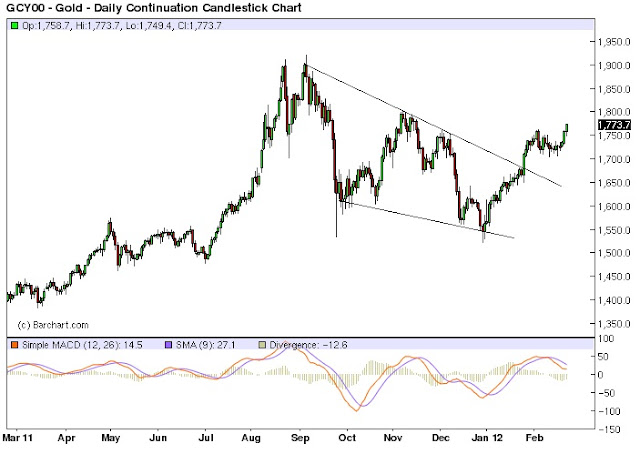By
Scott Silva
Editor,
The
Gold Speculator
2-28-12
Gold
and silver are headed higher propelled by a powerful bull trend. Gold is
climbing on its way to new multiyear highs, buoyed by massive government
intervention in the capital markets. We will see gold exceed its 2011 highs
this year. Silver will also soar to new highs.
What
is behind this bullish prediction? Can we pinpoint the cause and effect
relationship to the rise in the precious metals? Is now the time to buy gold
and silver?
The
answers to these questions come with a firm understanding of the dynamics of
the business cycle, and the power of market trends. As we know from Mises and
Hayek, interest rates have a profound effect on capital investment. Left to the
free market, interest rates are determined by the supply of credit (a proxy for
the savings rate) and investors’ willingness to risk placing capital in the
market (a proxy of the return on capital). And as we know from Adam Smith, because
investors act in their own self-interest, capital is allocated in free markets
very efficiently. Investors tend to put more capital in “winners” and are quick
to cut the losses in “losers”.
But
if free markets are so efficient, how can there be downturns in the economy,
ranging from recession to depression?
The cause of most economic downturns has been manipulation in the markets,
typically by government agencies that seek to “manage” one or more segments of
the economy by controlling interest rates, prices or both. Governments use
coercion under the color of law to achieve their ends. Government intervention
distorts natural interest rates and spoils price discovery, which leads to
malinvestment and market bubbles. Downturns and displacement occur when
economic bubbles burst.
The
Federal Reserve has been one of the chief market manipulators. By setting
interest rates and controlling the availability of credit and money, the Fed
distorts the natural demand for money and credit, which obscures purposeful
capital investment and contaminates prices for labor and commodities, often
with disastrous results. When the Fed feeds artificial credit into the economy
by lowering interest rates, it spurs investments in projects that eventually
fail. The high-tech and dot com and housing manias all were fueled by decades
of easy Fed money and credit. In each case these artificially induced booms
collapsed with massive loss of wealth and devastation of the general economy.
The
data support the theory of cause and effect. The dot come run up coincided with
a money supply run up which began in 1995. The money supply slightly flattened
in 1996 and then zoomed up again in 1997, peaking at a 15% increase in January
of 1999. The rate of increase began to fall precipitously thereafter, which
popped the dot com bubble. The housing bubble, created by easy money and social
engineering in the 1990’s popped in 2007, creating the Great Recession. The Fed
and the Treasury added an unprecedented $2.3 Trillion to the money supply in
2008-2010 in the name of economic stimulus. The Fed’s MZM money supply measured
$907 Billion in 1980 and is reported to be $10.8 Trillion as of this month. The MZM does not reflect the $16 Trillion in
bailout loans the Fed provided to large US banks in 2008-2011. There is no doubt that judgments of investors
and entrepreneurs are distorted by massive injections of money and credit by
the Federal Reserve.
So
what does easy money and credit from the central bank have to do with the price
of gold? Well, every Dollar the central
bank creates out of thin air debases the value of Dollars already in
circulation. That is the nature of fiat currency. Because gold is priced in
Dollars, it takes more Dollars to buy the same amount of gold with every new
weaker paper Dollar printed. We have seen the price of gold climb along with
the money supply, accelerating its climb in 2002 coincident with the fall in
the Dollar.
We
are now seeing technical breakouts in gold and silver. Last week, gold broke
out of a bullish head-and-shoulders pattern dating back to November 2011. The
price target from this pattern is just over $2000/oz. Silver followed last week, with a breakout
from its own bullish head-and-shoulders pattern indicating a return to its
September 2011 highs.
The
trend in precious metals is up from here. Now is the time to buy gold, silver
and selected gold and silver stocks.
Investors from around the
world benefit from timely market analysis on gold and silver and portfolio
recommendations contained in The Gold
Speculator investment newsletter, which is based on the principles of free
markets, private property, sound money and Austrian School economics.
The
question for you to consider is how are you going to protect yourself from the
vagaries of the fiat money and growing inflation? We publish The Gold Speculator to help people make better decisions about
their money. Our Model Conservative Portfolio has outperformed the Dow and the
S&P 500 by more than 3:1. Subscribe at our web site www.thegoldspeculatorllc.com with credit card or PayPal ($300/yr) or by
sending your check for $290 ($10 cash discount) The Gold Speculator, 614 Nashua
St. #142 Milford, NH 03055









